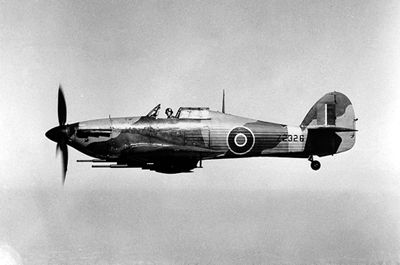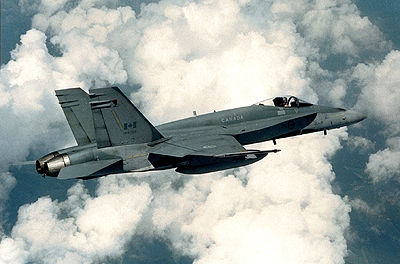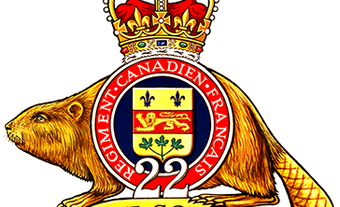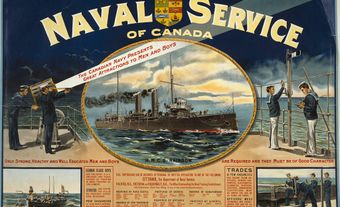Since its inception in 1924, the Royal Canadian Air Force (RCAF) has served Canadians in peace and war. It played a vital role in the Second World War, becoming the fourth-largest Allied air force, and reached its "golden age" in the late 1950s, with dozens of combat squadrons on the front lines of the Cold War. The term Royal, dropped from the name in 1968, was returned to the air force in 2011.

First World War
Aviation as a major part of a nation’s military forces had yet to be proven when Canada entered the First World War on 4 August 1914. A month later, the Canadian Aviation Corps (CAC) was created almost on a whim by the mercurial Minister of Militia, Sir Sam Hughes. The three-man, one-aircraft Corps virtually disintegrated upon its arrival in England and saw no service whatsoever.
A trickle of Canadian aviators were recruited directly, or transferred from service in the Canadian Expeditionary Force, into either England’s Royal Flying Corps (RFC) or Royal Naval Air Service (RNAS). With the implementation in January 1917 of a large-scale, Canada-based flight training scheme, appropriately named the RFC Canada, the trickle became a flood. Most of the graduates would serve in the Royal Air Force (RAF), created with the amalgamation of the RFC and RNAS in April 1918. By the end of the war, more than 20,000 Canadians had served in a British Empire flying service, and about 1,400 had died.
Canadian flyers established a record second to none; William “Billy” Bishop, Raymond Collishaw, Donald MacLaren and William “Billy” Barker, for example, were among the top 12 “aces” of the war (scoring more than 50 victories). Bishop, Barker, and Alan McLeod, an 18-year-old flyer from Manitoba, were awarded the Victoria Cross — the Commonwealth's highest award for military valour—for their actions in the air.
RCAF Launched
A short-lived Royal Canadian Naval Air Service (RCNAS) and an England-based Canadian Air Force were casualties of the rapid demobilization of military forces after the war. Between 1919 and 1924, Canada wrestled with creating a policy to govern the field of aviation, which few citizens, and even fewer politicians, understood. Thanks to the efforts of people such as John Armistead Wilson, a career public servant, an Air Board was created as an interim measure to develop aviation policy, rules and regulations. And a Canadian Air Force (CAF) was re-established as a “flying militia” using wartime flyers and surplus British aircraft. In 1923, the Air Board joined with the Department of Militia and Defence and the Department of the Naval Service to form the Department of National Defence (DND). The CAF was placed under a Director and made responsible to the Chief of the General Staff for the control of both military and civil aeronautics.
On 1 April 1924, the air service was renamed the Royal Canadian Air Force – the Royal sobriquet having been approved by King George V in 1923. The RCAF consisted of a permanent full-time air element, a Non-Permanent Active Air Force (NPAAF) intended to train for a few weeks each year, and a Reserve Air Force to be called upon during national emergencies.
Throughout the 1920s, the RCAF focused on Civil Government Air Operations. It used small detachments—normally one or two aircraft and a handful of personnel—for diverse purposes such as aerial mapping, spotting forest fires, fisheries patrols, assisting government departments and exploring the feasibility of flying in the Canadian North through undertakings such as the Hudson Strait Expedition in 1927–28. Often operating from makeshift camps, the RCAF came to be symbolized by the ubiquitous “flying boat,” and a can-do practical approach that led to the nickname of “bush pilots in uniform.”
Limited military training was conducted, until the Great Depression in the early 1930s forced Ottawa to drastically reduce government spending. Almost overnight, the RCAF was reduced in size by one-fifth and its budget halved, forcing a shift from civil operations to flying in support of military requirements. Scarce resources were used to form NPAAF squadrons in major cities to provide a nucleus for future RCAF growth.
By 1935, an improved economy and the growing importance of aerial defence brought increased funding for the RCAF, allowing limited but steady expansion. In 1938, the senior air officer became directly responsible to the Minister of National Defence, thus making the air force a separate service equal in status to the Canadian Army and Royal Canadian Navy. That same year, a re-organization led to the creation of Western and Eastern Air Commands. In the midst of these changes, when war erupted in September 1939, the RCAF could only muster 4,061 personnel of all ranks and 270 aircraft, of which only 19 could be considered reasonably modern.
Second World War
In 1939, Prime Minister William Lyon Mackenzie King agreed to support a major air training scheme located throughout the Commonwealth,
but with its largest component in Canada. Signed on 17 December 1939, the British Commonwealth Air Training Plan (BCATP) resulted in a rapid expansion
of the RCAF as aviation schools were built throughout the country. Of the more than 131,000 airmen trained in Canada, almost 73,000 were Canadian and a large portion would fulfill their wartime service in Canada as part of the Home War Establishment
engaged in training and support tasks. Other airmen found themselves in the thick of combat engaging German submarines in the Atlantic (see Battle of the Atlantic),
while on the West Coast, RCAF personnel operating with the American military helped remove Japanese forces from the Aleutian Islands in Alaska.
The first three RCAF squadrons were sent to England during the first six months of 1940 — No. 1 (Fighter) Squadron arrived just in time to participate in the Battle of Britain. The RCAF overseas grew rapidly, establishing a strong presence within British formations such as Fighter, Coastal and Transport Commands. By far the greatest concentration of Canadian airmen served within No. 6 (RCAF) Group, Bomber Command. Although there would be a total of 48 RCAF squadrons, as well as numerous other units, serving in theatres of war ranging from Europe to the Far East, the vast majority of Canadians abroad served in RAF organizations.
By late 1944, the RCAF reached its peak as the fourth largest Allied air force with more than 215,000 personnel in uniform, including about 17,000 members of the Women’s Division. By the time the war ended, more than 18,000 members of the RCAF had given their lives in the service of their country.
Did you know?
Actor Robert Clothier was one of the many young Canadians who served with Bomber Command during the Second World War. He was awarded the Distinguished Flying Cross on 5 December 1944 and praised for his “courage, coolness and confidence.” Later that month, he was seriously injured in a crash. He was paralyzed from the waist down for the next two years. Following the war, Clothier became an accomplished stage and television actor. Among other roles, he played the character “Relic” on The Beachcombers, one of the most successful Canadian television series of all time.
Bravery
Four Canadian airmen were awarded Victoria Crosses posthumously for bravery during the Second World War. Three of them saw service in Europe — Andrew Mynarski and Ian Bazalgette while serving with Bomber Command, and David Hornell with Coastal Command. Naval Lieutenant Robert Hampton Gray of the Royal Canadian Naval Volunteer Reserve was awarded the Victoria Cross while flying off Royal Naval aircraft carriers in the Far East against Japanese forces.
The Far East was also the setting for the dramatic story of Squadron Leader Leonard Birchall, hailed as the Saviour of Ceylon. On 4 April 1942 he was the pilot of a 413 Squadron Catalina flying boat that spotted a Japanese fleet intent on attacking Allied forces on the island of Ceylon (now Sri Lanka). He radioed a warning and kept up surveillance of the enemy until his aircraft was shot down. Although a number of his crew perished, Birchall was captured and held as a prisoner of war by the Japanese for more than three years under the most brutal conditions. Birchall stood up to his captors while in captivity, demanding humane treatment for his fellow prisoners for which he was often beaten and abused. Awarded a Distinguished Flying Cross for his actions on 4 April, and the Order of the British Empire for his tenacious struggle in support of other prisoners of war, Birchall had a long and distinguished career in the postwar RCAF.
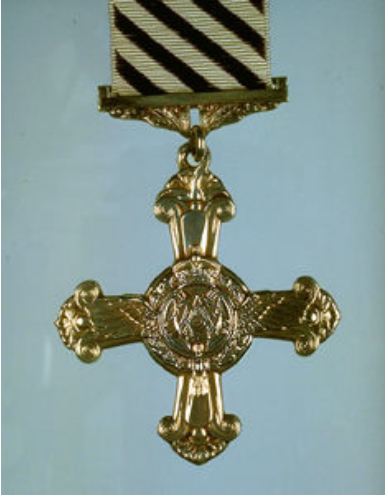
Golden Age
After demobilization, the RCAF numbered about 12,000 personnel by 1948. However, deteriorating relations between Western governments and the Soviet Union (see Cold War) spurred Canada to join the North Atlantic Treaty Organization(NATO) in 1949. It also led to the creation of the Canada–United States North American Air Defence Agreement(NORAD) in 1956 and increased Canada's support for the United Nations. Born out of a desire for collective defence, these organizations had a profound impact on the RCAF and sparked an unprecedented level of peacetime growth.
During the Korean War (1950–53), the RCAF provided an air transport squadron, fighter pilots, nurses and other personnel to UN Command. No. 426 “Thunderbird” Squadron ferried people and supplies throughout the combat phase; this included 599 round-trip flights between Tokyo and McChord Air Force Base in Washington state as part of the United States Air Force (USAF) Material Air Transport Service. As the RCAF was heavily committed to NATO operations in Europe, no Canadian fighter squadrons were involved in Korea. Yet 22 RCAF pilots flew with the USAF during the war. By 1957, approximately 1,000 members of the RCAF had contributed to the UN mission in Korea, whether during the combat (1950-53) or peacekeeping phase. This included 40 RCAF flight nurses, who served on medical evacuation flights.
Did you know?
Flight Lieutenant Omer Levesque was the first RCAF combatant of the Korean War. Levesque began an exchange posting with the USAF in June 1950 and flew to Korea in November with his squadron. On the flight between San Francisco and Honolulu, he was accompanied by Flying Officer Mary Joan Fitzgerald, the first RCAF flight nurse to participate in the war.
By the end of the 1950s, there were 12 squadrons of Canadian fighters operating from NATO airfields in France and West Germany. In North America, the NORAD commitment resulted in the formation of numerous interceptor squadrons as well as the building and manning of radar sites throughout the country and far north. The RCAF also provided significant aviation support for UN peacekeeping missions in the Middle East and Asia. With all these responsibilities, the RCAF had more than 50,000 personnel by the end of the decade.
The 1960s saw the RCAF introduce nuclear weapons—controlled by the United States—to equip the European-based CF-104 Starfighter, as well as to equip North American air defence CF-101 Voodoo squadrons and the two Bomarc missile sites in Canada. The use of these weapons was controversial in Canada and by 1983, the last of the nuclear-equipped systems was retired.
The 1960s also ushered in two decades of financial restraint and the gradual decrease in the size of Canada’s military forces. Technological changes, spiralling defence costs and budget reductions played havoc with the Canadian aerospace industry. The “golden age” of the RCAF in the 1950s—highlighted by the Canadian-built F-86 Sabre and CF-100 Canuck fighters—gave way to the cancellation of expensive projects such as the Avro Arrow interceptor, and an increased reliance on US-built aircraft.
Unification and Lean Times
In an effort to save money and increase efficiency, Paul Hellyer, Canada’s Minister of National Defence from 1963 to 1967, unified the Canadian Army, Royal Canadian Navy and the RCAF to create the Canadian Armed Forces. The RCAF, as well as the flight organizations of the army and navy, collectively became known as the Air Element. Its various parts were scattered among a number of commands and not until the stand-up of Air Command in 1975, with a strength of just over 23,000, would there be a recognizable "air force" in Canada. Virtually none of the national and international commitments had disappeared, but it was a much smaller military aviation establishment that had to deal with them.
Throughout the 1990s Air Command faced a number of challenges. The collapse of the Soviet Union in 1991 generated demand for a “peace dividend” and the redirection of Canadian government funds to other priorities. The pressure to cut military spending, made worse by a downturn in the economy, resulted in lean times for the Canadian Forces and Air Command in particular. Between 1991 and 1999, the regular component of the air force shrank from just over 20,000 to 13,500 as whole fleets of aircraft were disposed of. Numerous bases, including those at Lahr and Baden-Soellingen, Germany, in 1993, were closed during this period.
The cuts led to a reorganization of the air force that saw the disbandment of functional commands in favour of one-operational headquarters at Winnipeg, Manitoba, as well as the imposition of a numbered “Wing” structure to emphasize Air Command’s authority at air-heavy bases throughout the country. In this manner, Canadian Forces Base Trenton, Ontario, within Air Command, was now referred to as 8 Wing Trenton.
Amid these changes, the air force faced an unprecedented level of commitment at home and abroad. Canadian maritime, transport and fighter aircraft and personnel found themselves in combat for the first time since the Korean War as part of an Allied coalition during the Persian Gulf War over the winter of 1990–91. On the heels of this operation were deployments in support of the UN in Africa and the Far East, and in support of NATO in the Balkans. That particular mission put Canada's CF-18 fighters into combat—this time in the skies over Kosovo in the spring of 1999—for the second time in less than 10 years. In Canada, assisting Canadians during the Oka crisis, the 1997 Red River flood and the 1998 ice storm combined with regular training, surveillance and search and rescue duties to push the air force to its limit.
21st Century
Although the air force continued to serve Canadians at home and support humanitarian and UN missions overseas, the 11 September 2001 terrorist attacks on the United States created a new reality. Canada provided a safe haven for diverted civilian aircraft, and the air force's CF-18s patrolled Canadian skies as part of a NORAD response. By January 2002, Canadian maritime and transport aircraft were supporting international counterterrorism operations in the Persian Gulf and Afghanistan. The commitment of large numbers of Canadian troops to Afghanistan as part of NATO’s International Security Assistance Force required ongoing airlift support, but the growing number of casualties on the ground in Afghanistan drove the need for a larger air force presence. From December 2008 until August 2011, a 450-strong Canadian Air Wing consisting of CH-146 Griffon and CH-147D Chinook helicopters, CC-130 Hercules aircraft and Unmanned Air Vehicles served out of Kandahar, Afghanistan.
As the Afghanistan mission was winding down, the Canadian air force was committed between March and November 2011 to support NATO operations in Libya. Hard-pressed transport units including the CC-177 Globemaster, CC-150 Polaris Airbus and CC-130J Hercules aircraft now had to support both the mission in Afghanistan as well as the operation in Libya. However, the air force's most public and visible role during this period was the repatriation of the remains of Canadian soldiers killed in Afghanistan—and the poignant televised images of flag-draped caskets coming off transport aircraft arriving in Canada.
On 16 August 2011, the Canadian government announced that once again the “Royal” Canadian Air Force would be part of the Canadian Armed Forces, and the term "RCAF" was once again in formal use. In November 2014, for the fifth time since the end of the Cold War, the RCAF engaged in combat operations, this time as part of the coalition fighting Islamic extremists in Iraq. A “small” air force with large domestic commitments and global reach, the RCAF continues to be a fundamental part of Canada’s defence forces.
(See also: Military Aviation)

 Share on Facebook
Share on Facebook Share on X
Share on X Share by Email
Share by Email Share on Google Classroom
Share on Google Classroom





